Before building a foundation, you need to decide on its type and dimensions, prepare the necessary materials. In order to prepare a sufficient amount of raw materials for the concrete mixture, a formula describing the volume of the foundation is needed.
General information
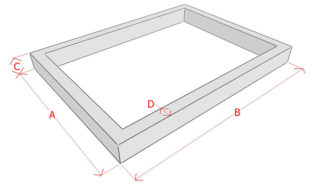
When deciding on the preferred type of foundation, it is first necessary to find out what operational characteristics the soil has in a given area. The construction of a building without a preliminary study of the soil is fraught with its premature exit from service. Before calculating a cube of concrete for a foundation, design its configuration, taking into account:
- soil characteristics (composition, mobility, particle size, water level, heaving tendency);
- depth of soil freezing;
- construction of the building being erected.
Based on the results of studying the soil, it is necessary to determine whether it can carry the design load. For example, if the soil is heaving, it is impossible to equip a shallow tape structure on it. If necessary, changes are made to the planned dimensions of the base. Their values and the reinforcement scheme determine how much concrete is needed for the foundation. This data is substituted into the calculated expression and the desired result is obtained.
It is important to calculate the cubic meters of the foundation for economic reasons and for the reliability of the building. An insufficient amount of the mixture for a given volume is especially dangerous: in this case, the base simply cannot bear the required load. If you buy components for pouring with a large stock, resource costs will be excessive.
Calculation of concrete for a strip foundation
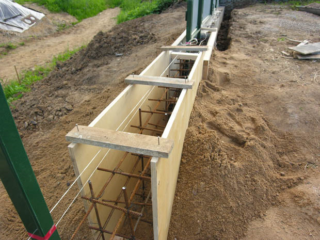
When arranging such a base, concrete is poured into a timber formwork reinforced with a mesh frame. To make the structure stronger, rubble or gravel is added. To calculate concrete for a strip foundation, you will need to determine its linear dimensions. As a rule, the minimum value for the height of the aboveground part is 40 cm, width - 30 cm.
The most variable parameter is depth. It depends on the levels of soil freezing and the occurrence of groundwater, as well as the architectural design of the building (the number of floors, the presence of a basement). For a bathhouse or a light house on a good site, a deepening of 1.5 m is suitable. In the case of "problem" soil or large dimensions of the building, it will increase to 2-2.5 m. The length of the tape is equal to the total length of the walls (including the internal bearing).
To determine how much the solution will have to spend, the formula for the volume of the foundation is used: V = a * h * l... Here V - the volume of concrete, but - belt width, l Is its length, and h - the total height of the structure. It is recommended to enter a correction factor of 1.02 into the general expression: if the density of the formwork is insufficient, the mixture may flow out. In addition, some of the materials are lost during transportation. The total is: V = 1.02 * a * h * l... If the result is a number with a fractional part (for example, 26.38 m3), it is rounded up towards a larger integer (in this case, up to 27).
Calculation of concrete for a columnar base
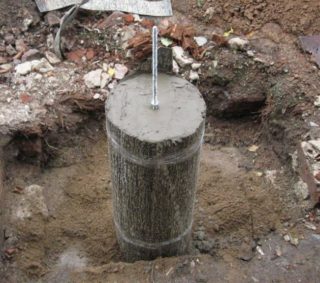
Recessed supports at such a base are formed by pouring the solution into the prepared deep (below the freezing mark) niches.The pillars are placed along the perimeter of the building and at the junction of the walls. In section, they can be in the form of a square or a circle. The supports protrude 0.4-0.5 m above the ground, uniting into a common structure with a grillage.
Before calculating the cubic capacity of the foundation, you need to decide on the number of pillars, their height and section parameters. In addition, the dimensions of the grillage are important (its volume is calculated according to the same scheme as that of the strip base). Then the cross-sectional area of the column is determined in accordance with its shape (circle or quadrilateral) and linear parameters (radius or lengths of the sides). Next, you need to find the volume of supports from the expression V = n * S * l. S in this formula - the area of the column cut, n - their number, l - total height (consisting of the outer and underground parts). To find the total volume of concrete, the cubes of the grillage and pillars are added. The resulting expression is multiplied by the safety factor k = 1.02.
Calculation of concrete for slab foundation
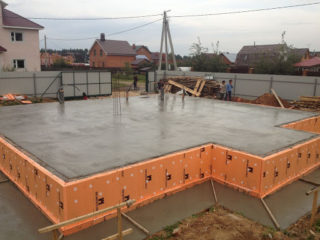
It is easy to determine the volume of a solid slab: for this, its width, length and thickness are multiplied. The latter should not have a value less than 0.1 m, otherwise the base will not be able to withstand the weight of the building. For a shed or bath, a foundation of 15 cm is suitable.For a residential building, this value will be greater. At the same time, making the slab too massive (thicker than 0.4 m) is also impractical.
To make the base stronger, it is often equipped with longitudinal (and sometimes, in addition to them, and transverse) stiffeners. Their volume is calculated separately and added to the value for the slab itself. Since the reinforcement elements are trapezoidal, you will need to calculate its area: S = h1 * (x + y) * 0.5where x and y - the base of the figure (usually they have a ratio of 3: 2), and h1 - rib height. The total volume of rigid parts is as follows: V1 = S * l * n (n - the number of fortifiers). This value is added to the slab volume and then multiplied by a factor of 1.02.
Consumption of components for 1 cubic meter of solution
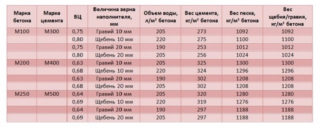
Having calculated the volume of the foundation in m³, it is also necessary to determine the required amount of mixture components. It depends on the preferred concrete grade and the type of cement used. To equip the foundation, concrete must have a digital indicator of at least 100. To prepare a mixture marked 200 from cement of the M400 type, you will need to mix it with sand and crushed stone in a ratio of 1: 2.8: 4.8. If you need concrete grade 300 or 400, there will be no such pronounced dominance of the last two components. For the manufacture of grade 400 mortar from M400 cement, the C: P: U ratio will have the form 1: 1.2: 2.7, for M500 - 1: 1.6: 3.2.
To calculate how many cubic meters of concrete will be required for pouring the base, you need to find the volume of the planned structure. To take into account possible losses of raw materials, a correction factor of 1.02 is used.








